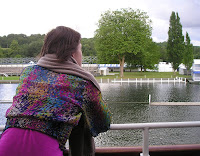
Today I was at the
Umbrella conference, giving a session about Second Life with Keri Gray, who runs the specialist recruitment agency
Weekes Gray Recruitment. If we put our PowerPoint online I will link to it. In fact working with Keri on this is an example of the use of Second Life to collaborate, since before today we hadn't actually met in person, but our joint session seemd to go well once we had sorted out the technology.
There were sessions about information literacy at Umbrella, but unfortunately they were yesterday (when I was at the LTEA conference) or running in parallel with my session. If I find some blog posts about them or further information I will link to it.
The session I
did attend was a good one;
Building a successful library Web 2.0 service in 7 steps. Since it has the magic figure 7, like Phil Race's talk (that I blogged in my last post) I decided to blog this now and post the other LTEA items over the next couple of days.
The Web 2.0 talk was given by
James Smith (Electronic Information Librarian for Sunderland Public Libraries) and
Nick Stopforth (Library and Information Officer at Newcastle Libraries). The approach to the session was to have a slide with icons e.g. a bird sculpture, a telephone pole. Each icon represented a different marketing or strategic principle and each one was paired with a web 2.0 application and example(s) from Newcastle or Sunderland libraries. It wasn't obvious which was which and people in the audience picked an icon to determine what order they were talked about, thus adding a random element of surprise.
The seven principles were as follows. A couple were covered very quickly at the end (or I may not have been paying enough attention earlier on: though it was a very engaging presentation all round):
Customer Demand i.e. responding to demand: example was using Facebook to attract students to public libraries.
Partnership: the example here was podcasting - e.g. working with community radio station and also partnering to help get expertse about how to do podcasting effectively. It was described as a "Kick start in new direction" if you work with others. They played an example podcast from the Northern Children's Book Festival, with children describing Dr Who masks and monsters. This was part of developing children to be reporters and doing their own interviewing (an interview with the Lord Mayor was another example): the podcasts are here
http://www.ncbf.co.uk/multimedia/.
Project Based: the message was that a specific project goes down better with management, especially when they know the hardware/software will cost nothing. The example for this principle was using Twitter, for example for the opening of the new city library at Newcastle (which lasted about 3 months in terms of run-up and event).
Service Needs: They mentioned meeting service objectives using communicaton tools - for example use of the
Hexagon chat/webcam tool.
Skills development: The issues around using a wiki for staff sharing were described: it seemed a good idea, but it turned out after a while that emails saying things had been updated were being blocked by the local system, so that people weren't aware that new content was going on and neglected it
Targetted: In terms of targetting your audience, they used example of Mashups, with the target audience being schoolchildren. They got a Flickr account, and justified its use by showing it was part of a project aimed at an audience that did not currently use libraries. They put on archival images of Sunderland post World War 2 , and worked with schools for the children to put themselves in these archival pictures. There's also a link on Google maps that shows where the pictures were taken and where bombs in 2WW fell, and where the actual targets (shipyards etc) were. Interestingly this shows how the German bombers tended to under or overshoot. Additionally they were able to link in stories on the BBC "
People's war" website. This is Sunderland Libraries Flickr stream
http://www.flickr.com/photos/sunderlandpubliclibraries/The final principle was
Participation (apologies I don't seem to have noted the example for this!)
Photo by Sheila Webber: Peace rose, Sheffield, July 2009






















